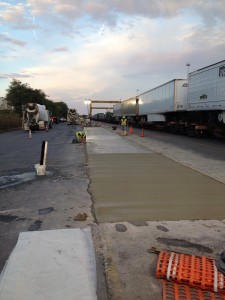How Does Concrete Cure?

Concrete is an ever-increasingly popular material that’s being used for different purposes all the time. Its low-cost yet reliable qualities have made it a common and useful material for a wide variety of purposes. If you’re planning on using concrete in your next project, it’s important that you understand how it works. For instance, curing is an important process when it comes to using concrete.
What Does It Mean to “Cure” Concrete?
Curing is the process of keeping the right moisture levels inside of cast concrete. When you add water to the concrete mix, you start the process of hydration. During it, the cement and water react with each other to form calcium silicate hydrate compounds. These compounds fuse with other compounds within the mixture to form strong bonds.
To put it simply — curing concrete is what makes it strong.
Curing occurs after you’ve mixed and poured the concrete. As the cement and moisture are reacting, the concrete will become harder, denser and stronger.
The Purpose of Curing Concrete
Now that you know curing is what gives concrete its strength, it’s easy to understand why the process is important. Curing makes concrete stronger by making it less porous. When it’s cured properly, concrete has greater durability and the ability to withstand the elements. It’s less susceptible to damage from several factors, like temperature changes.
When concrete is not properly cured, it may break down much faster than properly cured concrete. Before getting started on the process, it’s important to thoroughly understand all the steps.
Depending on the structure, improperly cured concrete could cause a great deal of damage and potential injury, resulting in severe losses. Take the time to do the job right and avoid these possible consequences.
How Long Does Concrete Cure For?
The reactions that occur during curing never technically stop, but the process is considered finished when the concrete reaches full strength. The length of the curing process varies, but it typically takes about 28 days. The total length is dependent on several factors:
- Water amount: It’s essential to use the correct amount of water during curing. When you use too little water, the process will end too soon. When concrete cures too fast, it won’t be as strong. If you use too much water, it will weaken the top layers of the concrete. This mistake could lead to flaking and possibly affect the integrity of the rest of the structure.
- Temperature: In warmer temperatures, curing will occur faster. As mentioned before, concrete that cures in too short a time will not be as strong.
- Wind: Similar to higher temperatures, wind can make the concrete cure more quickly. This issue also leads to weaker concrete.
- Mix components: In some concrete mixes, accelerants are added. These types of mixes are used when a concrete structure needs to be ready quickly. They meet concrete standards, but the resulting material will be weaker than concrete that was allowed to cure for a longer amount of time.
Learn more about our residential and commercial concrete services and contact us to begin your next concrete project.


